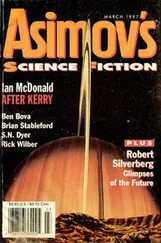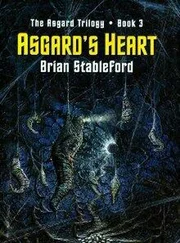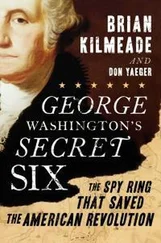When we’d eaten, Susarma Lear insisted on taking her turn in the driving-seat. She assured me that she couldn’t possibly make any mistakes driving across a flat plane with not another vehicle in sight from horizon to horizon, but I insisted on sitting beside her to make sure that everything was in order. Not everything was, of course; when she checked with her ship, its watchful observers reported that we were being followed by three trucks, two of which looked conspicuously bigger than ours.
“Have the Tetrax in Skychain City been able to give us any indication what sort of firepower they’re packing?” she asked.
“Needlers, mostly,” the man on the ship reported. “They’re petty criminals, not trained soldiers. If you want to take them on, you could probably eliminate them from consideration—but you’d need cover to mount an ambush. We consulted the Tetrax about the possibility of trying to take them out from up here, but they didn’t like the idea one little bit.”
“No,” said Susarma Lear, grimly. “I have this sneaking suspicion that they’d rather the petty criminals got their hands on the goodies than the Star Force. I don’t think we can expect too much help from them.”
“If they’d been in a co-operative mood, they could have prevented the bad guys from exiting the dome,” the man on the ship agreed.
“That’s true,” I put in, “but if they’d been in an unco-operative mood, they could have stopped us too. We know where they stand—on the sidelines. It may not be the best place, if things get interesting.”
“Keep watching,” the star-captain instructed her contact on the ship. “I’m certainly not going to start a pitched battle up here, even if we do find a likely spot for an ambush. I can’t afford to risk any losses until I catch up with the android. After that… well, anything goes. We’ll do things the Star Force Way.”
I wondered if Amara Guur would have had the sense to quiver in his boots if he’d heard her say that. Probably not—he wouldn’t have understood the niceties of her tone and expression. I did.
I returned to my careful study of the notebook, with all due patience and determination.
After a while, the star-captain said: “I suppose the Tetrax must already have learned quite a lot, from the stuff they’ve already dug out of the upper levels. They must have already stolen quite a march on the rest of us.”
“Not unless they’re keeping a lot of secrets from their esteemed colleagues in the C.R.E.,” I said. “Which isn’t impossible, of course—but I think they’re still waiting for the crucial breakthrough. The technics we’ve excavated so far aren’t significantly more advanced than the devices we already have. No matter how clever Asgard’s builders were, the people who actually lived in the habitats in the outermost levels seem to have been humanoids not much different from us.”
“Passengers, you mean?”
“Maybe. Species rescued from endangered worlds who didn’t have the wherewithal to save themselves is the most popular guess.”
“So if the lower levels are similar,” she said, “it might not matter whether they’re dead or alive—they might be just more of the same.”
“It’s a possibility,” I admitted. “But basing their technics on the same spectrum of scientific knowledge would necessarily make their technology the same as ours. The humanoid races we know about are similar, but they have quite various technological styles. What I mean…”
“I know what you mean,” she said. “Heavy metal-minded, like us. Biotech-minded, like the Salamandrans… and the Tetrax.”
“Well, yes,” I admitted. “Reduced to the crudest possible level, that’s about it. Different kinds of sociopolitical systems tend to be associated with different technologies. When 69-Aquila was lecturing me in my cell, he said that you could ignore one direction of the causal flow and regard the technologies as the ultimate determining factor, but that’s just as brutal an oversimplification as yours. Different humanoid races produce different kinds of social organization for a variety of reasons—some anatomical, some ecological, some historical—but they all have their idiosyncrasies, and those idiosyncrasies are reflected in matters of technological style. Technology is art as well as science, maybe more art than science. That’s one of the reasons why the people at the C.R.E. are so interested in the stuff we find in the levels, even though it doesn’t actually do anything that we can’t already do in our own subtly different fashion. Even if the lower levels are full of passengers, they won’t be uninteresting… and if some of the passengers can talk to us, they might have some very interesting things to say.”
“And Lyndrach’s notebook says that there’s people down there, does it?” she asked, nodding towards the black-bound object in my hand. That was why she’d started the conversation—she wanted me to keep her up to date with what I’d found.
“Not exactly,” I admitted. “Actually, vif is pretty much the full extent of what it says , in actual words. But what that implies…”
She didn’t seem to like the answer, or the way I left it hanging. “Isn’t a whole lot, from what you’ve told me so far. I need details, trooper. Hard data.”
There was plenty of hard data in the book, but not the kind she was fishing for. Even if it had been written in English, she’d still have needed me as an interpreter.
“Actually,” I pointed out, “I’ve told you a whole lot more than you’ve told me. I’ve told you practically everything I know, in fact—but you still haven’t told me why you’re so hell-bent on catching and killing Myrlin.”
“It’s a military secret,” she told me. “Strictly need-to-know. You don’t need to know. You just have to guide me to him.”
“Right,” I said. “The proverbial Star Force Way. Everybody follows orders, and shoots when they hear the word ‘Fire!’ No ifs and buts, just blood and guts.”
“Sometimes,” she said, “it’s the way things have to be done. Sometimes, it works.”
“And sometimes it doesn’t,” I countered. “This is Asgard. Here, we generally do things the Tetron way. That works most of the time.”
“Maybe so,” she said. “But even here, it’s the Tetrax who do things the Tetron way—not the vormyr or the Spirellans, apparently. Personally, I do things the Star Force Way—and so do you. Your choice was between my way and Amara Guur’s way, and you chose mine. It was a wise choice—but now you’re stuck with it. So stop asking questions that I can’t answer, and tell me exactly what Lyndrach’s notebook says. Never mind what it implies— just tell me what it says.”
Sleep had soothed her temper for a while, but the kind of stress she was carrying obviously wasn’t the kind you could sleep off in a matter of hours.
“Saul found some kind of dropshaft,” I told her, meekly repeating what I’d deduced from the notebook. “He managed to rig some ropes so that he could get down to the bottom, but he didn’t have the equipment he needed to cut his way out. All he could manage was to drill a peephole. On the other side it was warm and it was light. He couldn’t see much, because he was looking into a room inside a building—a deserted building, in an advanced state of dilapidation. He could see what looked like fungi, plants, insects… but he couldn’t see out through the window because it was blocked. Very frustrating. But a building is evidence of builders—and decay of that sort isn’t the work of millions of years. It implies…”
“I can do the conjectures myself. This is where the android’s going?”
Читать дальше












